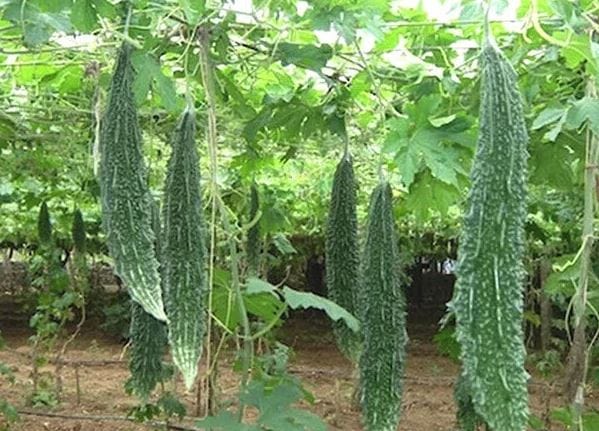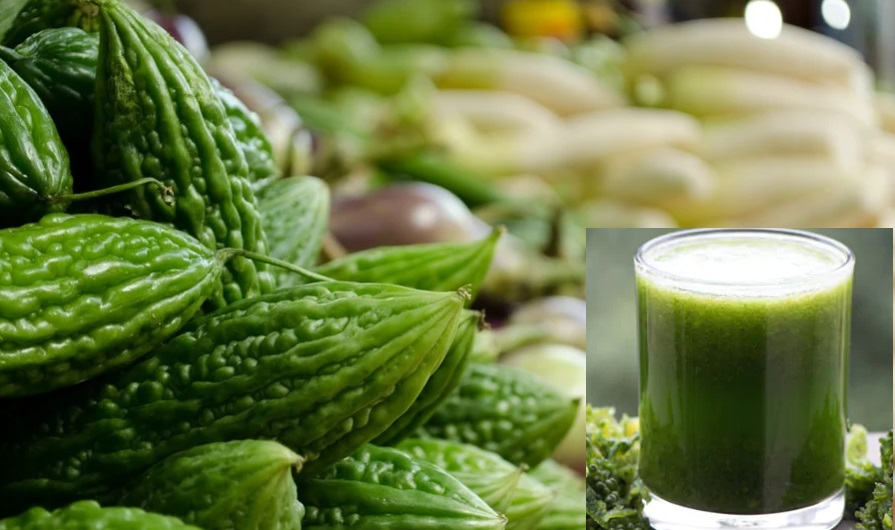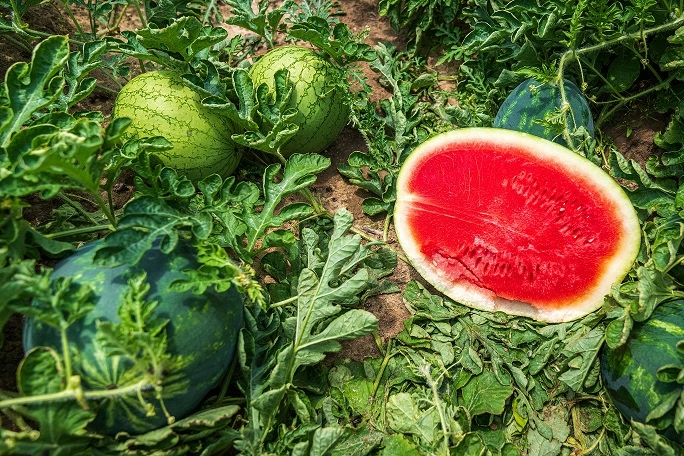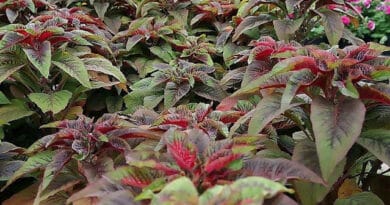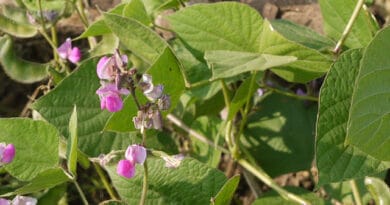Cultivation of Bitter Gourd
Cultivation of Bitter Gourd: Due to its high nutrient content and therapeutic characteristics, it provides numerous health benefits.
Bitter Gourd, Memordica charantia linn. belongs to the family Cucurbitaceae, other common names are Bitter cucumber, Bitter melon, Bellsom Pear, and African cucumber. It is one of the most important cucurbitaceous vegetables grown extensively throughout India. It differs from other cucurbit vegetables due to its bitter taste because of alkaloids momordicine and triterpine glycosides, which are the bitterest chemical compounds in the plant kingdom
The bitter gourd originated in the tropics of the Old World and is widely distributed in China, Malaysia, India, and tropical Africa. Bitter Guard is found growing wildly in many areas of India
Nutritive Value of Bitter Gourd;
| Proximate principles | Quantities |
| Moisture (g/100 g) | 83.2 |
| Carbohydrates (g/100 g) | 10.6 |
| Proteins (g/100 g) | 2.1 |
| Fiber (g/100g) | 1.7 |
| Calcium (mg/100 g) | 23 |
| Phosphorus (mg/100 g) | 38 |
| Potassium (mg/100 g) | 171 |
| Sodium (mg/100 g) | 2.4 |
| Iron (mg/100 g) | 2 |
| Copper (mg/100 g) | 0.19 |
| Manganese (mg/100 g) | 0.08 |
| Zinc (mg/100 g) | 0.46 |
| B Carotene | 126 |
| Vitamin C | 96 |
Source: Gopalan et al. (1993). Nutritive value of Indian foods. National Institute of Nutrition, ICMR, Hyderabad.
Medicinal Properties of Bitter Gourds;
2 It lowers bad cholesterol levels in our body
3 It is for glowing skin and lustrous hair
4 Cures hangovers and cleanses the liver
5 Helps in weight loss
6 Boosts your immune system
7 Excellent for your eyes
Climate Requirements of Bitter Gourd Cultivation;
Soil and Its Preparation for Bitter Gourd Cultivation
Bitter Gourd Varieties
| Varieties | Developed By | Characteristics |
| Arka Harit | IIHR Bangalore | Fruits are short, spindle-shaped. Green-colored with smooth, regular ribs and moderate bitterness.Yield 9-12 t/ha.It is selected from a local collection. It is most suitable for growing during the summer. Fruits are glossy green, medium long, and thick. |
| Pusa Do Mausami | IARI | Fruits are dark green, club-like, with 7-8 continuous ribs. Fruit weight 100-120 g. Yield 12-15 t/ha. |
| Pusa Hybrid 1 | IARI | The thickness of its fruits is medium.It is long and glossy green yielding up to 20 t/ha in 120 days |
| Coimbatore Long | TANU | Its fruits are long, tender, whitish It is suitable for rainy season crops, Average yield is up to 25-30 t/ha. |
| CO.1 | TANU | CO-1 fruits are dark green.it has a medium length (20-25 cm) Weight (100-120 g).Yield 14 t/ha. |
| Kalyanpur Baramasi | CSA, Kanpur | Its fruits are long (30-35 cm),have a light green color, thin and tapering,Tolerant to fruit fly and mosaic disease,Yielding 20 t/ha up to in 120 days. |
| VK-1-Priya | SAU, Kerala | Its fruits are white and are 35-40 cm long.Heavy bearing variety,with the first picking starts in 60 days.Average yield is up to 50 fruits/plant. |
| Preethi (MC 4) | SAU, Kerala | It has medium-sized white fruits with spines.It’s av. fruit length 30 cm, with an av. fruit girth of 24 cm.Av. fruit weight 0.31 kg.Productivity is up to 15.0 t/ha-1,The fruits of this variety are 25 -30 cm long. dark green with tubercles. |
| Phule Ujwala | MPKV, Rahuri (MS) | It is very suitable for exports.Its fruits are 18-20 cm in length, dark green with tubercles, average yield up to 30-35 t/ha, It is suitable for exports. |
| Phule Priyanka | MPKV, Rahuri (MS) | It is a hybrid variety having dark green color fruits. Fruits are 20-25 cm in length, have tubercles. Average yield is up to 35-40 t/ha. |
Sowing of Seeds;
(a) Time of sowing. sowing can be accomplished from January to March for the summer season crop, June to July for the rainy season crop in the plains, and March to June in the hills.
b) Seed rate. The seed rate is 2.0 to 2.5 kg per Acre
(c) Method of sowing. The seed is sown by the dibbling method with a spacing of 120×90 cm. Generally, three to four seeds are sown in a pit at 25 to 3.0 cm.
The seeds should be soaked in water overnight before sowing to achieve better germination. Seed germination was enhanced by soaking the need for 24 hours in a solution of 25 or 50 ppm GA and 25 ppm boron
(d) Plant Support System: Bitter gourd, being a frail climber, needs support for its development. The plants trailed on the support (bower) keep on giving yield for 6-7 months as against 3-4 months when trailed on the ground without support.
Such vines are less defenseless to pests and diseases as they don’t come in direct contact with the soil. In the bower framework, planting is done at a separation of 2.5 x 1m.
Furrows are opened up at 2.5 m, and water system channels are spread out at 5-6 m distance. Wooden poles (3 m in height) are pitched on both the finishes of interchange furrows a ways off of 5 m. these posts are associated with wires.
The wires along the furrows are additionally associated with cross wires affixed at 45cm distance to frame an organization of wires.
Seeds are drilled at a distance of 1 m along the furrow and secured gently with soil. The vines take about 1.5-2 months to arrive at the bower height, consequently, the vines during the underlying phases of development are trailed on ropes till they arrive at the bower. When the vines arrive at the bower height, the new rings are then trailed on the bower.
Manuring in Bitter Gourd Crop;
The application of fertilizer may vary depending upon the variety, Season, and type of soil. Apply well-decomposed cow dung @ 4-6 tons per acre at ploughing. It requires about 24 kg of nitrogen,12 kg of phosphoric acid, and 12 kg of potassium.
Intercultural operation in Bitter Gourd Crop
Two to three hoeings are given to keep down the weeds at the early stage of growth. The rainy season crop is usually stalked, often trained on a bower made up of bamboo and sticks
Diseases and Pests of Bitter Gourd;
Insect pest of Bitter Gourd;
Pest | Symptom | control |
Red pumpkin beetle | Adults feed on the foliage, buds, and flowers. Grubs feed on roots | Preventive measures like burning of old creepers, ploughing & harrowing of fields after the harvest of crops to destroy the stages of the pest. Beetles should be collected & destroyed in the early stage of its infestation. Spraying with 0.05% malathion or dusting with 5% malathion dust @ 10 kg/ha. |
Melon Fruit fly | Active during March-May. Attack fruits. Reddish dark brown flies with hyaline wings lay eggs under the skin of the fruits; Maggots feed on the pulp of fruits. Infested fruits start rotting and rendered them unfit for human consumption; Fruits show dark-brown, rotten, circular patches and fall off prematurely | Clean cultivation, i.e. remove and destroy all the fallen & infested fruits on daily basis. Deep ploughing to expose hibernating stages.Application of spray baits.Spraying with 0.05% malathion or 0.2% carbaryl at flowering. |
Aphid | Colonies of nymphs and adults attack leaves and tender shoots and suck the sap; Leaves curl and dry up. | Remove infested leaves and shoots in the initial stage;Spray 0.02% Pyrethrins |
Diseases of Bitter Gourd;
Disease | Symptoms | Control | |
Powdery Mildew | Powdery Mildew is favored by high humidity and tends to occur on older leaves first. Symptoms can be found as a white powdery residue mainly on the upper leaf surface. Whereas circular patches or spot are visible on the lower surface of the leaves. In severe infestation, these can be spread, coalesce, and cover both the surfaces of the leaves and may be spread up to the petioles, stem, etc. Severely affected leaves become brownish and shrivelled and defoliation may also occur. The affected fruit plants show stunted growth. | Apply the Carbendazim (1 ml/liter of water) or Karathane (0.5 ml/liter of water) sprayed immediately after the appearance of the disease. 2-3 sprays are taken at an interval of 15 days. | |
Downy mildew | Downy mildew is caused by the fungus Pseudoperonospora cubensis. It is very common in areas of high humidity, especially under the condition when summer rains occur regularly. The disease is first observed as yellow angular spots on the outer surface of the leaves. In the prevailing conditions of high humidity, whitish powdery growth appears on the inner surface of the leaves. The disease spreads rapidly and destroys the plant through accelerated defoliation. | Control of this disease can be achieved with Ridomil (1.5 g/litre of water) which must always be used simultaneously with a protectant fungicide such as Mancozeb (0.2%) to prevent the development of resistant strains. | |
Bitter Gourd Mosaic | This virus disease is mostly confined to the leaves with symptoms appearing on the leaves in the secondary branches produced at the apical end of the plant. Small irregular yellowish patches are visible on the leaves. Some leaves show vein clearing in one or two lobes of the leaf and severely infected plants show a reduction in leaf size and elongation and/or suppression of one or two lobes. Young developing leaves are completely distorted and malformed with considerable reduction in their size. Some of the leaves show a marked reduction in the development of lamina resulting in a shoe-string effect. The virus is transmitted by five species of aphids. | Spraying of the crop should be done just after germination with chemicals like ; Monocrotophos (0.05%) or Phosphamidon (0.05%) at 10-day intervals to prevent aphid vectors. | |
Harvesting of Bitter Gourd Crop;
Harvesting is done when the fruits are still young and tender every alternate day.
Picking should be done carefully so that the vine may not be damaged.
The fruits should not be allowed to mature on the vines.
The harvested fruits may be stored for 3 to 4 days in cool conditions.
Bitter Gourd Yield per Acre
The yield is 4000 kg per small-fruited variety (Uchchhe) and 6000 to 8000 kg per long and large-fruited (Karela) variety per acre.
Read Further;
Cultivation of Bottle Gourd ( Lauki )
Cultivation of Celery in India; A full Information Guide
